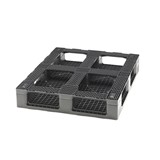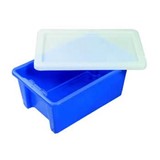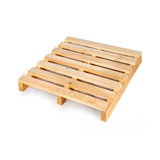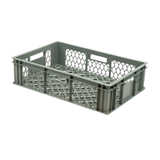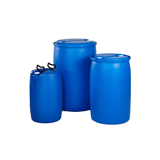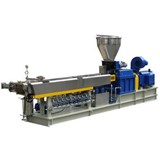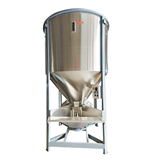Upgrade your warehouse storage with plastic pallets, Nally megabins, and crates. Learn how these hygienic, durable solutions boost efficiency and comply with Australian standards.
Key takeaways
- Hygiene advantage: Plastic storage solutions reduce contamination risks by being easy to clean and pest-resistant, critical in food, pharmaceutical, and healthcare sectors. Studies show plastic pallets reduce bacterial contamination by up to 90% compared to wooden alternatives (Food Safety Magazine, 2022).
- Durability and lifespan: Plastic pallets and bins typically last 5–10 years or more, outlasting wooden pallets that last 3 years on average (Australian Packaging Covenant Organisation, 2023).
- Cost efficiency: Despite higher upfront costs ($30–$200+ per plastic pallet depending on type), the longer lifespan, lower maintenance, and reduced pest control costs mean a lower total cost of ownership over time.
- Space-saving: Folding bins can reduce storage footprint by up to 70% when empty, improving warehouse layout and flexibility.
- Export and compliance: Plastic pallets meet ISPM-15 phytosanitary standards for export without the need for fumigation, saving time and costs on international shipments.
Introduction
In today’s fast-paced warehouse, distribution, and manufacturing environments, efficiency and hygiene are top priorities. Transitioning from traditional wooden or metal storage solutions to plastic options like plastic pallets, Nally Megabins, plastic storage crates, and folding bins can transform your operations.
This guide breaks down the practical benefits of plastic material handling equipment tailored for Australian businesses. You’ll learn how to select the right plastic storage items that enhance cleanliness, comply with export regulations, save space, and improve overall cost-effectiveness.
Why plastic? Hygiene, durability, and recyclability compared
Plastic storage products offer several distinct advantages over wood and metal:
- Hygiene: Plastic surfaces are non-porous and easy to wash down, reducing risks of contamination, mould, and bacterial growth—a key consideration in food, pharma, and cleanroom environments.
- Durability: Plastic does not splinter or rust, resisting weather, moisture, and chemicals better than wood or metal.
- Recyclability: Many plastic pallets and bins are made from recyclable polyethylene or polypropylene, supporting sustainable waste management.
- Pest control: Plastic products eliminate pest infestations common with wooden pallets, reducing the need for fumigation or chemical treatment.
Choosing between plastic crates, bins, and megabins: size, stacking, and ventilation
Understanding the differences helps you select the ideal container for your needs:
- Plastic crates: Typically smaller, rigid containers perfect for handling small parts, packaged goods, or bulk items. Ventilation holes aid airflow, ideal for perishable products.
- Plastic storage bins: Larger than crates, used for bulk storage or assembly line feeding. Some have lids for protection or can be stackable to maximise vertical space.
- Nally Megabins: Large capacity bins (up to 1000L), ideal for storing and transporting large volumes of raw materials or finished goods. They often feature forklift pockets for easy movement and collapsible versions for efficient return logistics.
Folding bins for space-saving logistics and seasonal overflow
- Folding bins can collapse flat when empty, saving up to 70% of space in return trips or storage.
- They are ideal for seasonal businesses with fluctuating inventory volumes or for multi-site operations needing flexible storage.
- Robust and hygienic, folding bins reduce the need for disposable packaging and improve warehouse flow.
Using plastic pallets for export compliance and food-grade transport
- Plastic pallets conform to ISPM-15 international phytosanitary standards without fumigation or heat treatment, reducing delays and costs.
- They are approved for food-grade applications, being free of contaminants like oils, splinters, or chemicals found in wooden pallets.
- Plastic pallets come in various designs—nestable, stackable, and heavy-duty—to suit different load requirements and transport modes.
Maintenance and cleaning best practices
Proper care of plastic pallets, crates, megabins, and folding bins ensures hygiene, safety, and long-term use. Here’s how to maintain them efficiently:
Daily and weekly care
- Inspect regularly for cracks, warping, or sharp edges.
- Clean with a hose or sanitising wipes; avoid harsh abrasives or steel wool.
Industry-specific cleaning
- Food and beverage: Use food-safe detergents and rinse thoroughly.
- Pharmaceutical: Apply biocidal cleaners approved for sterile environments.
- General warehousing: Neutral pH detergent with warm water is typically sufficient.
Monthly deep cleaning
- Separate stacked items to reach hidden surfaces.
- Check drainage ports on megabins and folding bins.
- Store indoors or shaded to prevent UV degradation.
Compliance and Australian standards overview
Meeting compliance standards is critical for workplace safety, export readiness, and hygiene in plastic storage equipment.
Food safety (HACCP)
- Use food-grade plastic with smooth, easy-to-sanitise surfaces.
- Ensure equipment is certified HACCP-compliant or ISO 22000-aligned.
Workplace safety
- Equipment must have accurate dynamic and static load ratings.
- Follow the WHS Manual Handling Code of Practice (2021) for safe lifting and use.
Export compliance
- Plastic pallets don’t require ISPM-15 treatment, making them ideal for export.
- Still meet AQIS requirements and check dimensions for freight standards.
Recyclability and sustainability
- Choose products with the Australian Recycling Label (ARL).
- Look for supplier-led recycling or buy-back programs.
Total cost of ownership: lifespan, cleaning, and pest control benefits
- While plastic pallets range between $30 to $200+, their longer lifespan (5–10 years) and low maintenance reduce replacement and cleaning costs.
- No need for pest control treatments saves Australian businesses an average of $500–$1,000 per annum per warehouse (AusPallets Report, 2023).
- Plastic storage bins and megabins also reduce labour time spent cleaning or repairing damaged wooden containers, improving operational efficiency.
FAQs about plastic storage solutions
Q1: Are plastic pallets recyclable in Australia?
Yes, many Australian recycling centres accept HDPE and PP plastic pallets, and some manufacturers offer take-back programs.
Q2: Can plastic crates be used outdoors?
Yes, but ensure the product is UV-stabilised for outdoor exposure to prevent brittleness and fading.
Q3: How do plastic storage bins compare in weight to wooden alternatives?
Plastic bins are generally lighter, making handling easier and reducing transport costs.
Q4: Are folding bins durable enough for heavy industrial use?
Modern folding bins use reinforced plastics designed for heavy loads, often rated up to 500kg or more.
Q5: How do plastic pallets improve food safety compliance?
Their non-porous surfaces prevent absorption of contaminants and are easier to sanitise, meeting food safety standards.
Conclusion
Upgrading to plastic pallets, megabins, storage crates, and folding bins delivers measurable benefits for Australian warehouses and manufacturers. Enhanced hygiene, durability, export compliance, and space efficiency lead to safer operations and lower total costs over time.
When selecting your plastic storage solutions, prioritise UV resistance, load capacity, and compliance with Australian regulations to ensure the best return on investment. Investing in smart plastic storage upgrades today future-proofs your warehouse for growth, safety, and sustainability.


